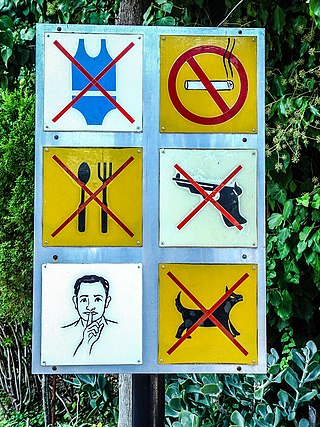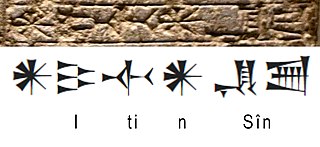
An ideogram or ideograph is a graphic symbol that represents an idea or concept, independent of any particular language, and specific words or phrases. Some ideograms are comprehensible only by familiarity with prior convention; others convey their meaning through pictorial resemblance to a physical object, and thus may also be referred to as pictograms.
Transliteration is a type of conversion of a text from one script to another that involves swapping letters in predictable ways, such as Greek ⟨α⟩ → ⟨a⟩, Cyrillic ⟨д⟩ → ⟨d⟩, Greek ⟨χ⟩ → the digraph ⟨ch⟩, Armenian ⟨ն⟩ → ⟨n⟩ or Latin ⟨æ⟩ → ⟨ae⟩.

Writing is a medium of human communication which involves the representation of a language through a system of physically inscribed, mechanically transferred, or digitally represented symbols.

The Egyptian language or Ancient Egyptian is a dead Afro-Asiatic language that was spoken in ancient Egypt. It is known today from a large corpus of surviving texts which were made accessible to the modern world following the decipherment of the ancient Egyptian scripts in the early 19th century. Egyptian is one of the earliest written languages, first being recorded in the hieroglyphic script in the late 4th millennium BC. It is also the longest-attested human language, with a written record spanning over 4000 years. Its classical form is known as Middle Egyptian, the vernacular of the Middle Kingdom of Egypt which remained the literary language of Egypt until the Roman period. By the time of classical antiquity the spoken language had evolved into Demotic, and by the Roman era it had diversified into the Coptic dialects. These were eventually supplanted by Arabic after the Muslim conquest of Egypt, although Bohairic Coptic remains in use as the liturgical language of the Coptic Church.

Akkadian is an extinct East Semitic language that was spoken in ancient Mesopotamia from the third millennium BC until its gradual replacement by Akkadian-influenced Old Aramaic among Mesopotamians by the 8th century BC.

Egyptian hieroglyphs were the formal writing system used in Ancient Egypt, used for writing the Egyptian language. Hieroglyphs combined logographic, syllabic and alphabetic elements, with some 1,000 distinct characters. Cursive hieroglyphs were used for religious literature on papyrus and wood. The later hieratic and demotic Egyptian scripts were derived from hieroglyphic writing, as was the Proto-Sinaitic script that later evolved into the Phoenician alphabet. Through the Phoenician alphabet's major child systems, the Egyptian hieroglyphic script is ancestral to the majority of scripts in modern use, most prominently the Latin and Cyrillic scripts and the Arabic script, and possibly the Brahmic family of scripts.
A phonetic complement is a phonetic symbol used to disambiguate word characters (logograms) that have multiple readings, in mixed logographic-phonetic scripts such as Egyptian hieroglyphs, Akkadian cuneiform, Japanese, and Mayan. Often they reenforce the communication of the ideogram by repeating the first or last syllable in the term.

Jean-François Champollion, also known as Champollion le jeune, was a French philologist and orientalist, known primarily as the decipherer of Egyptian hieroglyphs and a founding figure in the field of Egyptology. Partially raised by his brother, the scholar Jacques Joseph Champollion-Figeac, Champollion was a child prodigy in philology, giving his first public paper on the decipherment of Demotic in his mid-teens. As a young man he was renowned in scientific circles, and spoke Coptic, Ancient Greek, Latin, Hebrew and Arabic.

In a written language, a logogram, logograph, or lexigraph is a written character that represents a word or morpheme. Chinese characters are generally logograms, as are many hieroglyphic and cuneiform characters. The use of logograms in writing is called logography, and a writing system that is based on logograms is called a logography or logographic system. All known logographies have some phonetic component, generally based on the rebus principle.

Sumerian is the language of ancient Sumer. It is one of the oldest attested languages, dating back to at least 3000 BC. It is accepted to be a local language isolate and to have been spoken in ancient Mesopotamia, in the area that is modern-day Iraq.

Cuneiform is a logo-syllabic script that was used to write several languages of the Ancient Middle East. The script was in active use from the early Bronze Age until the beginning of the Common Era. It is named for the characteristic wedge-shaped impressions which form its signs. Cuneiform was originally developed to write the Sumerian language of southern Mesopotamia. Cuneiform is the earliest known writing system.

Classic Maya is the oldest historically attested member of the Maya linguistic family. It is the main language documented in the pre-Columbian inscriptions of the classical period of the Maya civilization. It is also a direct descendant of Proto-Mayan and the common ancestor of the Cholan branch of Mayan languages. Contemporary descendants of classical Maya include Ch'ol and Ch'orti'. Speakers of these languages can understand many Classic Mayan words.
All Chinese characters are logograms, but several different types can be identified, based on the manner in which they are formed or derived. There are a handful which derive from pictographs and a number which are ideographic in origin, including compound ideographs, but the vast majority originated as phono-semantic compounds. The other categories in the traditional system of classification are rebus or phonetic loan characters and "derivative cognates". Modern scholars have proposed various revised systems, rejecting some of the traditional categories.

Anatolian hieroglyphs are an indigenous logographic script native to central Anatolia, consisting of some 500 signs. They were once commonly known as Hittite hieroglyphs, but the language they encode proved to be Luwian, not Hittite, and the term Luwian hieroglyphs is used in English publications. They are typologically similar to Egyptian hieroglyphs, but do not derive graphically from that script, and they are not known to have played the sacred role of hieroglyphs in Egypt. There is no demonstrable connection to Hittite cuneiform.

Hieroglyphic Luwian (luwili) is a variant of the Luwian language, recorded in official and royal seals and a small number of monumental inscriptions. It is written in a hieroglyphic script known as Anatolian hieroglyphs.

Old Persian cuneiform is a semi-alphabetic cuneiform script that was the primary script for Old Persian. Texts written in this cuneiform have been found in Iran, Armenia, Romania (Gherla), Turkey, and along the Suez Canal. They were mostly inscriptions from the time period of Darius I, such as the DNa inscription, as well as his son, Xerxes I. Later kings down to Artaxerxes III used more recent forms of the language classified as "pre-Middle Persian".

Dingir is a Sumerian word for "god" or "goddess". Its cuneiform sign is most commonly employed as the determinative for religious names and related concepts, in which case it is not pronounced and is conventionally transliterated as a superscript "d" as in e.g. dInanna.

A writing system is a method of visually representing verbal communication, based on a script and a set of rules regulating its use. While both writing and speech are useful in conveying messages, writing differs in also being a reliable form of information storage and transfer. Writing systems require shared understanding between writers and readers of the meaning behind the sets of characters that make up a script. Writing is usually recorded onto a durable medium, such as paper or electronic storage, although non-durable methods may also be used, such as writing on a computer display, on a blackboard, in sand, or by skywriting. Reading a text can be accomplished purely in the mind as an internal process, or expressed orally.

The Caylus vase is a jar in alabaster dedicated in the name of the Achaemenid king Xerxes I in Egyptian hieroglyph and Old Persian cuneiform. It was the key element in confirming the decipherment of Old Persian cuneiform by Grotefend, through the reading of the hieroglyphic part by Champollion in 1823. It also confirmed the antiquity of phonetical hieroglyphs before the time of Alexander the Great, thus corroborating the phonetical decipherment of the names of ancient Egyptian pharaohs. The vase was named after Anne Claude de Tubières, count of Caylus, an early French collector, who had acquired the vase in the 18th century, between 1752 and 1765. It is now located in the Cabinet des Médailles, Paris.















